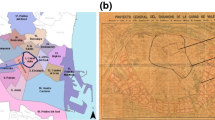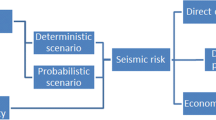Abstract
The seismic vulnerability assessment of Nepalese Pagoda temples is essential as these monuments are recognized with high historical and heritage value. Many of these architectural and culture heritage are listed in UNESCO World heritage. Rigorous vulnerability assessment of these structures and the implementation of appropriate retrofitting solutions can help reduce the levels of physical damage and the economic impact of future seismic events. This paper approaches the seismic vulnerability assessment of Pagoda temples by applying a simplified methodology developed. The proposed methodology adopted in this study was based on a vulnerability index used for the evaluation of damage and the study of loss scenarios on a large scale. Over 78 Pagoda temples located in three cities of the Kathmandu valley (Nepal) were assessed using this methodology. The results of the vulnerability assessment together with the surveyed database and damage classification were integrated into a GIS tool, allowing the spatial visualation of damage scenarios, which is potentially useful for the planning of retrofitting priorities to mitigate and manage seismic risk.






















Similar content being viewed by others
References
Balbi A, Lagomarsino, Parodi S (2007) Vulnerabilità sismica e rilevanza dei centri strorici e delle emergenze architettoniche: un’applicazione alla provincia di Imperia. In: Minciardi R, Ugolini (eds) Proceedings of La messa in sicurezza del terriotorio da eventi calamitosi di tipo naturale: Esperienze e nuove prosptettive, Lerici, Italy, 12 Sepetmber 2005, Alinea, Italy
Benedetti D, Petrini V (1984) Sulla Vulnerabilità di Edifici in Muratura: Proposta Di Un Metodo Di Valutazione. L’industria delle Costruzioni 149(1):66–74
Bhattarai GK, Chamlagain D, Rajaure S (2011) Seismic hazard assessment for eastern Nepal using 1934 and 1988 earthquakes. J Nepal Geol Soc 42:85–93
Bramerini F, Di Pasquale G, Orsini A, Pugliese A, Romeo R, Sabetta F (1995) Rischio sismico del territorio italiano. Proposta per una metodologia e risultati preliminari. Servizio Sismico Nazionale, Rapporto Tecnico, SSN/RT/95/01, Roma
Chaulagain H, Rodrigues R, Jara J, Spacone E, Varum H (2013) Seismic response of current RC buildings in Nepal: a comparative analysis of different design/construction. J Eng Struct 49:284–294
Coburn AW, Spence R, Pomodis A (1992) Factors determining human casualty levels in earthquakes: mortality prediction in building collapse. In: 10th WCEE, Madrid, pp 5989–5994
Combescure D, Guéguen P, Lebrun B (2005) Vulnérabilité sismique du bâti existant: approche d’ensemble. Cahier technique AFPS 25:121
Curti E (2007) Vulnerabiltà sismica delle Torri Campanarie: modelli meccanici e macrosismici. Ph.D. Thesis in Civil and Enviromental Engineering, Dipartimento di Ingegneria delle Costruzioni, Università degli Studi di genova, dell’Ambiente e del Territorio, 2007 (in Italian)
Dixit AM (1991) Geological effects and intensity distribution of the Udayapur (Nepal) earthuquake of August 20, 1988. J Nepal Geol Soc 7:1–17
Dolce M, Kappos A, Masi A, Penelis G, Vona M (2006) Vulnerability assessment and earthquake damage scenarios of the building stock of Potenza (Southern Italy) using Italian and Greek methodologies. J Eng struct 28(3):357–371
ESRI (2013) Geographic information systems ArcGIS. 380 New York Street, Redlands, CA 92373–8100, USA
Ferreira TM, Vicente R, Mendes da Silva JAR, Varum H, Aníbal Costa A (2013) Seismic vulnerability assessment of historical urban centres: case study of the old city centre in Seixal, Portugal. Bull Earthq Eng. doi:10.1007/s10518-013-9447-2
Formisano A, Florio G, Landolfo R, Mazzolani FM (2011) Numerical calibration of a simplified procedure for the seismic behaviour assessment of masonry building aggregates. In: Proceedings of the 13th international conference on civil, structural and environmental engineering computing, CC2011; Chania, Crete; 6–9 September 2011
Formisano A, Mazzolani FM, Florio G, Landolfo R (2010a) A quick methodology for seismic vulnerability assessment of historical masonry aggregates. In: Proceedings of the COST action C26 final conference ”Urban Habitat Constructions under Catastrophic Events”, Federico M. Mazzolani, Chair, Naples, 16–18 September 2010, CRC Press, Taylor & Francis Group, London, pp 577–582, ISBN: 978-0-415-60685-1
Formisano A, Mazzolani FM, Florio G, Landolfo R, De Masi G, Delli Priscoli G, Indirli M (2010b) Seismic vulnerability analysis of historical centres: a GIS application in Torre del Greco. In: Proceedings of the COST action C26 Final conference ”Urban Habitat Constructions under Catastrophic Events”, Federico M. Mazzolani, Chair, Naples, 16–18 September 2010, CRC Press, Taylor & Francis Group, London, pp 583–588, ISBN: 978-0-415-60685-1
Giovinazzi S (2005) The vulnerability assessment and damage scenario in seismic risk analysis. PhD Thesis, International doctorate, University of Florence, Technical University of Carolo-Wilhelmina
Giovinazzi S, Lagomarsino S (2004) A macroseismic model for the vulnerability assessment of buildings. In: Proceedings of 13th world conference on earthquake engineering. Vancouver, Canada, 1–6 August 2004, Paper no. 896
GNDT-SSN (1994) Scheda di esposizione e vulnerabilità e di rilevamento danni di primo e secondo livello (murata e cemento armato). Gruppo Nazionale per la Difesa dai Terremoti, Rome
Grünthal G (1998) European Macroseismic Scale 1998 (EMS-98), European Seismological Commission, Subcommission on Engineering Seismology. Working Group Macroseismic Scales, Cahiers du Centre Européen de Géodynamique et de Séismologie 15
Hazus MH (1999) Earthquake loss estimation methodology-technical and user manual. Federal Emergency Management Agency, Washington
JICA (2002) The study on earthquake disaster mitigation in the Kathmandu Valley Kingdom of Nepal. Japan International Cooperation Agency (JICA) and Ministry of Home Affairs, His Majesty’s Government of Nepal, vol 1, 110+p
KVPT (2014) Retrofitting, restoration, and reconstruction of Nepalese Pagoda temples. Kathmandu valley preservation trust, Patan Darbar Square, Nepal, http://www.kvptnepal.org
Lagomarsino S, Podestà S (2004) Seismic vulnerability of ancient churches: II. Statistical analysis of surveyed data and methods for risk analysis. Earthq Spectra 20(2):395–412
Lagomarsino S, Podestà S, Resemini S (2004) Observation and mechanical models for the vulnerability assessment of monument buildings. In: Proceedings of 13th world conference on earthquake engineering. Vancouver, Canada, 1–6 August 2004, Paper no. 942
Nienhuys S (2003) Options for reconstruction and retrofitting of historic Pagoda temples, reconstruction of temples in Kathmandu. HUYS ADVIES, Sept. http://www.nienhuys.info/mediapool/49/493498/data/Retrofitting_KVPT_HA_2003.pdf
Neves F, Costa A, Vicente R, Oliveira CS, Varum H (2012) Seismic vulnerability assessment and characterization of the buildings on Faial Island, Azores. Bull Earthq Eng 10:27–44. doi:10.1007/s10518-011-9276-0
Parajuli YK (1986) Bhaktapur development project (BDP): experiences in preservation and restoration in medieval town (1974–1985). Deutsche Gesellschaft fuer Technisches Zuzammenarbeit (GTZ), Frankfurt
Pradhan R (2000) Seismicity and traditional buildings of Kathmandu Valley, Nepal. In: Proceedings of the ICOMOS international wood committee (IIWC), Earthquake-safe: lessons to be learned from traditional construction, international conference on the seismic performance of traditional buildings, November 16–18, Istanbul, Turkey. http://www.icomos.org/iiwc/seismic/Pradhan.pdf
Quiroz AP (2011) Seismic vulnerability reduction of historical masonry towers by external prestressing devices. PhD Thesis, University of Braunschweig, Germany and University of Florence, Italy
Ramos LF, Lourenço PB (2004) Modeling and vulnerability of historical city centers in seismicareas: a case study in Lisbon. Eng Struct 26(9):1295–1310
Ranjitkar RK (2000) Seismic strengthening of the Nepalese Pagoda: progress report. In: Proceedings of the ICOMOS International Wood Committee (IIWC), earthquake-safe: lessons to be learned from traditional construction, international conference on the seismic performance of traditional buildings, 16–18 Nov, Istanbul, Turkey. http://www.icomos.org/iiwc/seismic/Ranjitkan.pdf
Ranjitkar RK (2006) Heritage homeowner’s preservation manual. Kathmandu valley World Heritage Site, Nepal: advice for maintenance of historic houses in the Kathmandu valley. Integrated Community Development and Cultural Heritage Site Preservation in Asia and the Pacific through Local Effort Programme (LEAP). UNESCO Bangkok, UNESCO Kathmandu. ISBN: 978-9937-2-0223-7
Roy SC, Dunn J, Auden JA, Ghosh AMN (1939) The Bihar–Nepal earthquake of 1934. Memoirs of the Geological Survey of India, v.73
Santos C, Ferreira TM, Vicente R (2013) Building typologies identification to support risk mitigation at the urban scale—case study of the old city centre of Seixal, Portugal. J Cult Herit 14(6):449–463
Shakya M, Varum H, Vicente R, Costa A (2014) A new methodology for vulnerability assessment of slender masonry structures. In: Proceedings of the 2nd European conference on earthquake engineering & seismology, 24–29 August, Istanbul
Shakya M, Varum H, Vicente R, Costa A (2013) Seismic sensitivity analysis of the common structural components of Nepalese Pagoda temples. Bull Earthq Eng. doi:10.1007/s10518-013-9569-6
Shakya M, Varum H, Vicente R, Costa A (2012) Structural vulnerability of Nepalese Pagoda temples. In: Proceedings of the 15th world conference on earthquake engineering, 24–28 Sept, Lisbon, Portugal, Paper no. 2919
Spence R, Bommer J, Del Re D, Bird J, Aydinoglu N, Tabuchi S (2003) Comparison loss estimation with observed damage: a study of the 1999 Kocaceli earthquake in Turkey. Bull Earthq Eng 1:83–113
Theophile E, Ranjitkar RK (1992) Timber conservation problems of the Nepalese Pagoda temple. In: Proceedings of the ICOMOS international wood committee, 8th international symposium, Norway, pp 85–124
UNDP, Bcpr (2004) Reducing disaster risk: a challenge for development. A global report. United Nations Development Programme/Bureau for Crisis Prevention and Recovery, New York, ISBN 92-1-126160-0
Upreti BN, Yoshida M (2009) Seismic hazard and mitigation activities in Nepal–with emphasis on Kathmandu Valley. J South Asia Disaster Stud 2(1):1–19
Vicente R, Parodi S, Lagomarsino S, Varum H, Mendes Silva JAR (2010) Seismic vulnerability and risk assessment: case study of the historic city centre of Coimbra, Portugal. Bull Earthq Eng. doi:10.1007/s10518-010-9233-3
Acknowledgments
The first author would like to express his gratitude to the scholarship under the Erasmus Mundus Action 2 Partnership, EU–NICE project, supporting the research developed within the PhD at University of Aveiro, Portugal.
Author information
Authors and Affiliations
Corresponding author
Rights and permissions
About this article
Cite this article
Shakya, M., Varum, H., Vicente, R. et al. Seismic vulnerability and loss assessment of the Nepalese Pagoda temples. Bull Earthquake Eng 13, 2197–2223 (2015). https://doi.org/10.1007/s10518-014-9699-5
Received:
Accepted:
Published:
Issue Date:
DOI: https://doi.org/10.1007/s10518-014-9699-5




